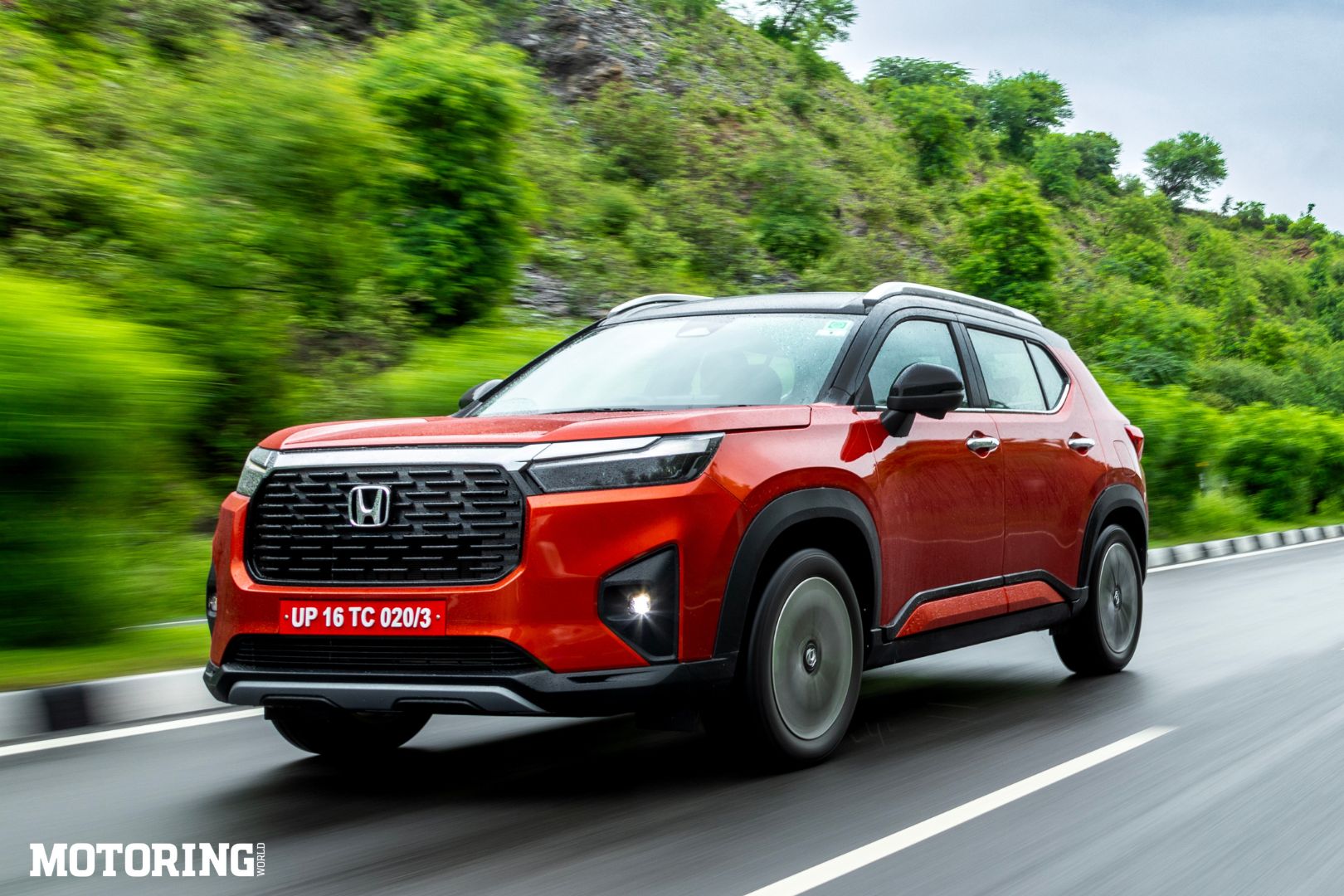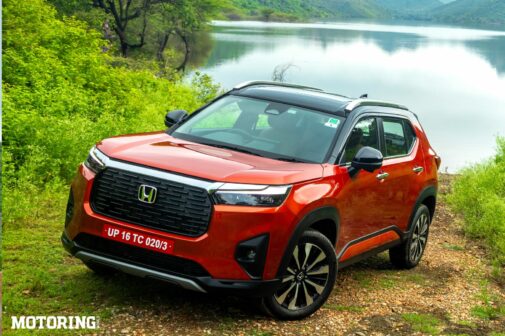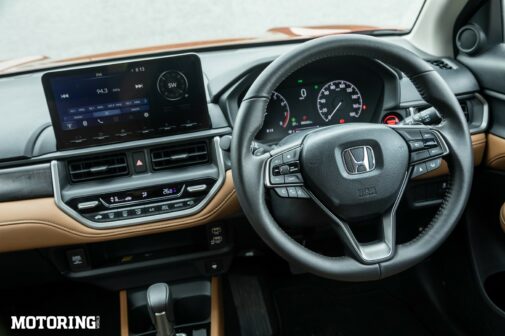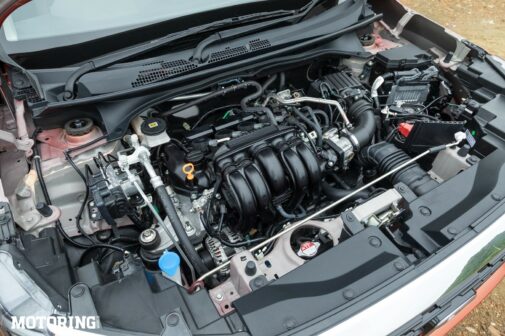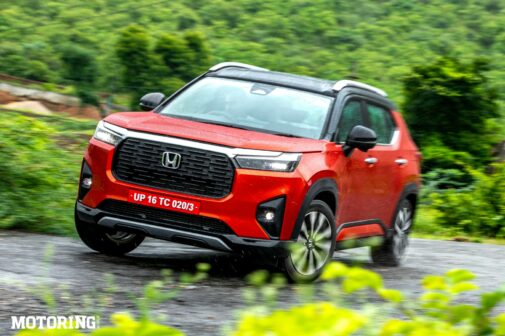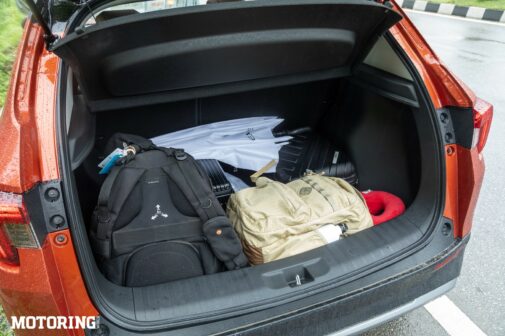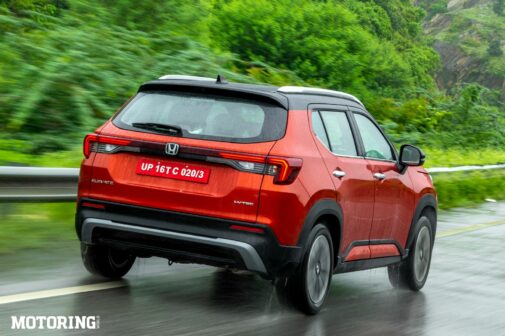The very first time I experienced the Honda Elevate, I tried out its rear seat first, which is unusual for me; I usually go straight for the driver’s seat in all-new cars. I’m not sure why I did this (actually I am – there was someone in the driver’s seat already), but I’m glad things turned out that way, since it’s the best seat in that particular house. Even when you peer through the rear window to look at the bench, it’s an inviting space, with its tasteful black-and-tan colour scheme. When you open the door and get in, the whole process is non-contortional, and settling into the seat is nice and easy. The well-padded faux leather seats are very comfortable, and I had plenty of room all-round to sprawl out – this is a very spacious and airy cabin. This should please both Honda loyalists – who are used to the City’s rear seat – and those thinking about the Honda badge for the first time, since both sets are likely to spend most of their time at the back; three adults will be quite comfortable there. The rear bench also folds in a 60/40 manner, for added practicality. Other conveniences at the back include bottle holders in the doors, A/C vents, a 12V socket and cupholders, and the capacious 458-litre boot will happily accept luggage for four.
They’ll be quite happy with the front row, too. The driver sits high up, so the view of the road is excellent, and these seats are comfortable as well. They’ll further appreciate things like the new 10.25-IPS inch touchscreen infotainment system (the biggest in a Honda in India), the wireless smartphone charger (which can be switched off if you just want a place to put your phone), the chunky steering wheel with controls for various functions and the fact that there are actual buttons and rocker switches for the A/C controls, rather than a touchscreen. The 7-inch TFT instruments are simple and tasteful (typical of Honda) and there are several other features that buyers have come to expect in a car in this class – paddle shifters, a sunroof, Android Auto/Apple CarPlay, connected car tech, automatic climate control, a pretty decent audio system and multi-angle external cameras, among others. Without quite being exceptional in any aspect, the Elevate’s cabin (at least in the top-spec versions) is an agreeable spot.
I know you’re waiting for the not-so-good bits, so here they are. The cabin, for all its pluses, doesn’t look and feel as nice as the ones that Hyundai and Kia offer. The piano black surfaces that Honda so loves are, as always, hugely prone to smudges and scratches, and the materials and overall fit and finish aren’t in the same league as that offered by the Koreans, who have set the benchmarks in this segment.
Step out of the cabin, take a few steps away from the car and you’ll see an SUV that’s very North American in design. That bold, flat front end, the chrome strip on top of the creased LED headlamps, the large fog lamp housings, the chunky grille and the scuff plate – all of these are quite un-Honda like in the Indian context. Personally, I think the look works – the Elevate looks quite hefty from the front. Honda has (quite sensibly) kept things simple with the rest of the car; the wheel-arch and door cladding adds some character to a profile that is otherwise uncluttered, and from the rear, the connected-strip lighting that’s all the rage these days is quite attractive. Once again, I can’t find anything to really complain about with the Elevate’s design, nor can I point out a memorable element.
I can, however, find some points of complaint when it comes to the engine. First, the facts. Honda has put its trusty 1.5-litre i-VTEC petrol engine into the Elevate, with 119 bhp and 14.8 kgm of torque. In the City, this is a great powerplant – refined, peppy and frugal. The City weighs around 100 kg less than the Elevate, though, and the consequence of the extra bulk it needs to handle becomes evident when you hit the road. It’s as quiet as always at startup, and when you’re driving around in city traffic it acquits itself well, but once you feel the need or desire to get moving quickly, the downside kicks in.
In this segment, Honda will be competing with cars that have diesels as well as turbocharged petrols, and the low-end torque you have access to with both kinds of engines is missing here. I was driving the Elevate with the CVT, and this engine-transmission combination struggles when you need near-instant acceleration. No matter what Honda says its done with the CVT, the rubber band effect is pronounced under acceleration, with the gearbox and the CVT feeling and sounding out of sync – and the cabin becomes a noisy place, especially when you’re driving uphill (this is despite the measures Honda says its taken to improve NVH levels).
If you’re cruising steadily at around 120 kph on a flat highway, things are much better, but as soon as you need to overtake a line of slow-moving trucks, or go up slopes quickly, the driving experience is compromised. Using the paddle shifters makes little to no difference, either; it’s only the 6-speed manual gearbox that improves matters considerably, but even this combination doesn’t feel as lively as cars from the competition. Furthermore, Honda’s own fuel efficiency figures of 15.3 kpl for the manual and 16.9 kpl for the CVT aren’t exactly segment-best, and with only a 40-litre fuel tank, overall range will take a bit of a hit. That said, both transmissions will be easy to use in largely urban conditions, where hard acceleration isn’t required that often, and the large majority of buyers will drive their Elevates in these conditions.
In terms of ride quality, the Elevate really backs up the comfort it offers in its rear seat. The suspension works away pretty silently, keeping the bad stuff on the roads separate from you. At both slow and high speeds, there’s no sign of skittishness or thudding, and the exceptional 220 mm of ground clearance means that you can take the Elevate through some pretty rough conditions, the likes of which I encountered quite often during the drive outside of Udaipur. The engine-gearbox combo may struggle, but during high speed lane changing the suspension never does, keeping the car absolutely well planted. The Elevate corners about as well as you can expect a large car to – there’s no sharpness to get excited about, but it goes exactly where you point it. The electronic power steering is no boy-racer, instead keeping things efficient and smooth, which is all buyers will want. You get disc brakes up front and drums at the rear, which is pretty standard for the segment, and they do their job efficiently; more feel from the pedal would have been nice.
Honda offers a range of camera-based safety features in the top-spec variants of the Elevate, with the Honda SENSING suite. These include things like collision mitigation braking, lane keeping assist, road departure mitigation, adaptive cruise control and lead car departure notification, among others, and I’m happy to inform you that I didn’t test any of them, which means I was doing the right things.
I don’t envy Honda’s position in the Indian automotive scenario at the moment. Gone are the days when people would buy a Honda and then keep buying a Honda because of the badge – the competition offers everything the Japanese manufacturer does and more. It’s very late to the SUV game, so it’s already playing catch up. It doesn’t have diesel or turbocharged petrol engines to offer, so all its eggs are in one basket, and as I mentioned, the engine-gearbox combinations in the Elevate have their issues. In such a competitive segment, the only way it can compete is on price – and it can’t afford to undercut the competition on a long-term basis, not if it cares for its bottom line, anyway. It would be an understatement to say that the Elevate has a lot riding on its broad shoulders, and I genuinely hope it works out well for the brand. It may be on the bland side of things, but at heart, it’s still a Honda.
AUTODATA
Honda ElevatePOWERTRAIN
Displacement:
Max Power:
Max Torque:
Transmission:
1498cc, four cylinder, petrol
119 bhp@6600 rpm
14.8 kgm@4300 rpm
6-speed MT/CVT
TYRES
F/R: 215/55 R17
DIMENSIONS
L/W/H (mm):
Wheelbase:
Ground Clearance:
Kerb Weight:
Fuel Capacity:
4312/1790/1650
2650 mm
220 mm
1206-1258 kg
40 litres
PRICE
TBA





